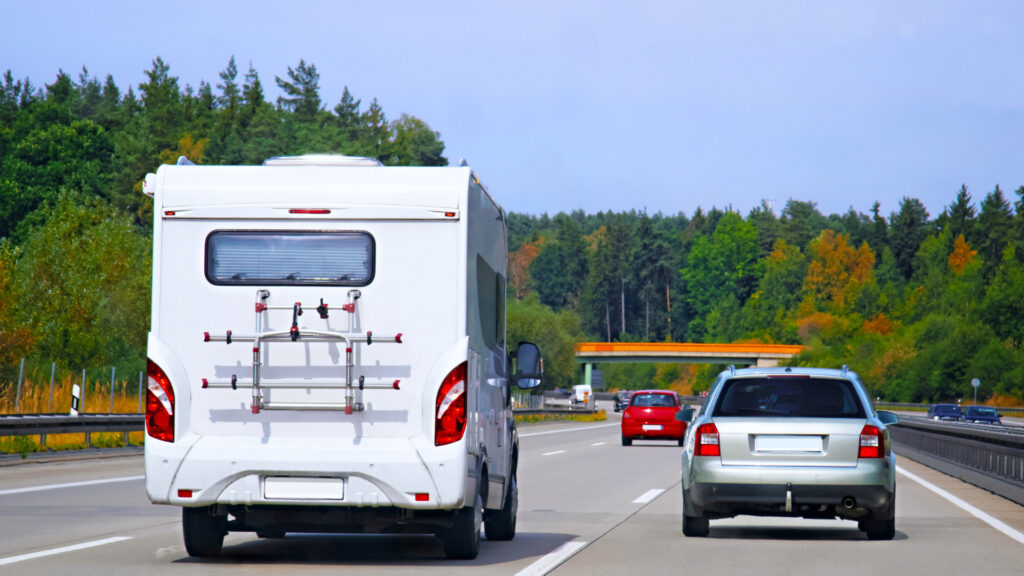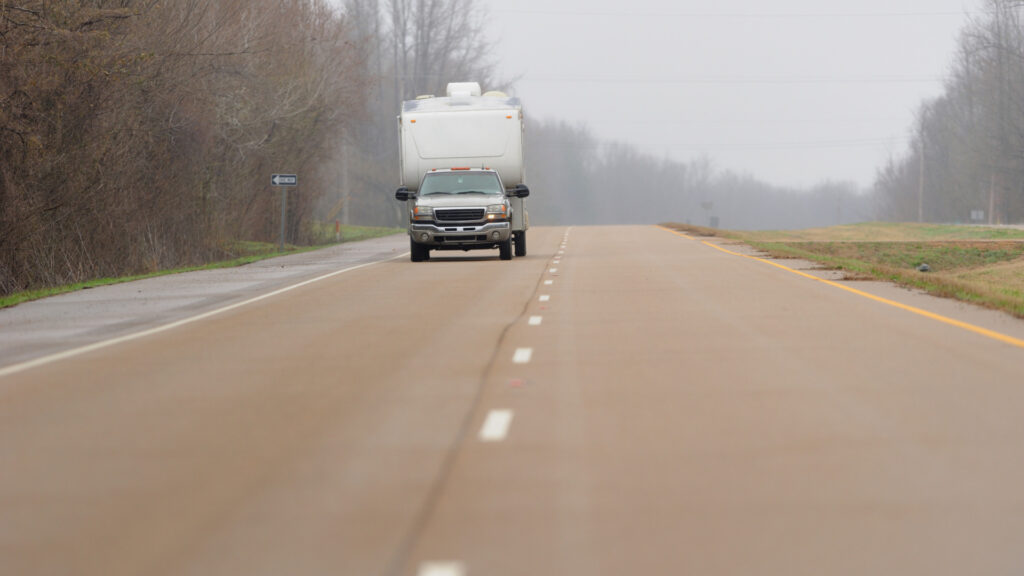Table of Contents Show
If you travel over state lines, the rules for RV driving can get tricky. Can I triple-tow?
Do I need to stop at weigh stations? Do I need to obey a different speed limit? It’s important to understand the rules for safe RV travel, so let’s tackle the question of speed limits for RVs.
If you don’t know what speed to go on interstates when driving or towing an RV, keep reading.
Do RVs Need to Obey Truck Speed Limits?
You’ve probably noticed that individual states set the speed limits.
Along Interstate-40 in North Carolina, the speed limit might be 65 miles per hour, but along I-15 in Utah, the speed limit might be 80. Each state also sets truck speed limits as necessary.
Thankfully, only five states require RVers to drive at a different speed than standard passenger cars. However, just to be safe, you should obey truck speed limits in California, Idaho, Indiana, Montana, and Washington.

Do RVs Have a Different Speed Limit Than Standard Vehicles?
As you travel across the country, you’ll find no set RV speed limit. You’ll see Class A motorhomes barreling down the interstate at 75 miles per hour. You’ll also see trucks pulling huge toy haulers going 60 on the same interstate.
A lot of times, it comes down to personal comfort. Most RVers will testify that driving under the speed limit is safer. Some won’t go over 60 miles per hour, especially when towing. Others feel safe around 70. But no laws designated an RV speed limit.
However, as mentioned above, five states require RVers to drive under the posted speed limits. For example, if you’re towing in California, you can’t exceed 55 miles per hour. It doesn’t matter your length or weight.
However, if you drive a motorhome and don’t have a towed vehicle, the law considers this a passenger vehicle, and you don’t have to remain under 55. However, once you connect that toad, you’re now towing and must drive slower.
How Fast Should You Drive an RV?
If you want to debate, gather a group of RVers and ask them how fast they should drive their RVs.
You have the one camp that says as long as they don’t shake or sway, they can go as fast as any other vehicle on the road. You have the other camp that says driving above 65 miles per hour gets too dangerous.
RVs are longer, heavier, and wider than standard passenger vehicles. If you’re new to RVing, drive under the speed limit to maintain control of the RV. However, many seasoned RVers will travel 70 to 75 miles per hour without thinking about it.
Speed also comes down to your tires. Trailer tires have ratings for certain speeds; if you don’t adhere to those, you risk tire failure. Typically, if you remain under 65 miles per hour, your trailer tires can handle the load capacity and speed of the RV.
What Could Happen If You Drive Too Fast in an RV?
Unfortunately, catastrophic events can occur if you drive too fast in an RV. First, your tires could blow.
The friction between the tires and the road generates heat, and if your tires get too hot, you could have to change a tire on the side of the road and pay for costly repairs.
You can also lose control of your RV if you drive too fast. A gust of wind could cause your trailer to sway, and the faster you drive, the harder it will be to get the trailer under control. You could cross over into another lane or cause an accident.
Additionally, you have less time to slow down and stop when you’re driving too fast. If a car suddenly veers into your lane and you’re going 75 miles per hour, it’ll be much harder to slow down than traveling 60 miles per hour.
Tips for Driving Safely in an RV
Speed isn’t the only important consideration when driving an RV. You can do other things to stay safe while on the road.
Keep Your Distance
As mentioned above, a 40,000-pound Class A will need much more room to slow down or stop than a 5,000-pound Honda CRV. You need to keep your distance between you and the drivers in front of you.
And leave ample room for drivers to merge onto the interstate. Don’t follow too closely when in heavy traffic. A safe speed at a safe distance means safe travel.
Keep in Mind: Before you hit the road, make sure you understand RV tire speed ratings before driving!

Stay in the Right Lane
Unless you need to pass, stay in the right lane. It’s easier to monitor traffic from your mirrors when you’re in the right lane. Plus, if you drive under the speed limit, you should always stay in the right lane. Other drivers expect slower traffic to keep right.
Shift Into a Lower Gear on Steep Down Grades
When traveling through mountain passes, shift into a lower gear. You’ll run at a higher RPM when going downhill in a lower gear, which allows the engine to better control the speed.
It doesn’t matter if you tow a camper or drive a motorhome. Help out your engine by shifting to a lower gear. You also won’t have to ride your brakes down the mountain.
Don’t Drive in Hazardous Conditions
Another important safety tip when driving is to stay alert to the weather conditions. It’s a good idea to download local and national weather apps to stay informed.
If at all possible, change your travel plans if the forecast predicts high wind warnings or dangerous weather conditions. Leave a bit earlier than planned or stay an extra night. It will be worth it to avoid driving in hazardous conditions.
Keep in Mind: While you should avoid driving in hazardous conditions, sometimes you’ll find yourself on the road in bad weather. If you have to drive in fog, here’s what you should do!

Don’t Drive at Night
Finally, driving during the day is best, especially in unfamiliar areas. If you take a cross-country road trip, you won’t know the curves and dips of the road like you might in your hometown.
You’re also more likely to feel tired if you drive at night, which is never good. Leave in the morning after a good night’s sleep and arrive at your next destination before dark. Then you won’t have to set up in the dark, either.
Stay Safe This Camping Season, and Enjoy the Journey
If you’re heading across state borders, know the state rules and regulations for motor vehicles. You certainly don’t want to ruin a camping trip with a high-dollar ticket because you didn’t realize RVs had to travel at a slower speed than passenger vehicles.
And stay safe by following the other driving tips this camping season so you can make more memories with your loved ones.
Is there a speed you feel most comfortable with when driving along the interstate?






